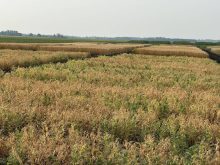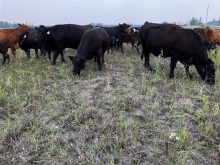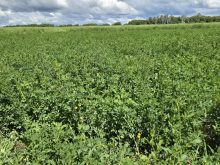While some potato growers are expecting to deliver on their contract volumes this year, others will once again be short thanks to heat and drought, adding yet another tough potato year into the record books.
Why it matters: Potatoes did not dodge the drought concerns suffered by other crops this year, and many producers are, once again, expected to fall short of their contracts.
As of Oct. 13, potato harvest in Manitoba was mostly complete, according to a seasonal summary from Manitoba Agriculture and Resource Development. Potatoes, like most other crops, had enjoyed good fall conditions and a speedy harvest, and disease had been mostly limited thanks to a dry growing season.
Read Also

Still hard to predict precise fertilizer payback
Despite decades of advances, international research finds no clear answer for where and when adding nutrient will fail to boost growth.
That, however, was the good news.
Like other crops, potatoes are also feeling the effects of a year that, as of the end of September, still had much of Manitoba in states of extreme or exceptional drought (anywhere from a one-in-20- to one-in-50-year drought), according to the Canadian Drought Monitor.
Dan Sawatzky, manager of the Keystone Potato Producers Association, estimated that areas like Carman and Winkler saw a disappointing two-thirds to three-quarters their normal processing potato crop this year. Much of the rest of central Manitoba, such as areas around MacGregor, also saw yield drops anywhere from 15 to 20 per cent, he said, with more mixed yields to the west around Carberry.
The province’s seasonal summery estimated below- to near-average yields in the central region, ranging anywhere from 275 to 350 hundredweight per acre.
“In certain areas of the province, we did run short of water, in particular those areas that rely on reservoirs,” Sawatzky said.
Potato producers were affected by the province’s dry spring, after lack of run-off failed to recharge either dugouts or the reservoirs typically relied upon for irrigation.
Growers around Winkler, for example, saw little to no recharge and little rain to make up the shortfall during the growing season, while Carman saw only partial recharge.
Heat, as much as lack of moisture, was a contributing factor to yield drops farther west, Sawatzky noted.
“Some of the set was lost,” he said. “And then, of course, they developed some heat runners… so quality is going to be a little bit compromised.”
At the same time, he noted, some western growers did have better results and will meet their contract amounts.
It’s hard to say exactly how short of contracted volumes Manitoba will fall as a whole, with harvest reports still coming in, according to Sawatzky.
Tough stretch
It is just one more in a series of bad potato years over the last four years.
In 2018, a challenging harvest left 5,200 acres in the field. Things were even worse the year after. Not so affectionately dubbed the “harvest from hell” by producers, fall 2019 saw a sharp turn in what had, until that point, been a dry year. Harvest stalled in multiple crops thanks to suddenly cold and wet weather, including a snowstorm in early October that dropped up to 75 centimetres of snow in parts of the province. In the end, an estimated 12,000 acres of potatoes were left undug that year, while another 1,000 went into storage with severe frost damage.
In both years, that poor harvest later translated into serious storage concerns, with producers fighting rot after crops were put into bunkers in poor condition.
Last year saw a reprieve on unharvested acres, although the potato sector reported, once again, that many yields were expected to be short. As a whole, the province’s production fell short of contract by about 17 per cent in 2020, according to Sawatzky.
“My prediction this year is we won’t be quite that short,” he said.
But unlike some previous years, this year the industry may find it difficult to make up the potato shortfall.
Recent years have seen processors draw potatoes from major potato-producing regions of the United States or Alberta to close the supply gap. This year however, Sawatzky noted that regions like Washington and Idaho, which have helped fill the gap in previous years, have also seen a lacklustre year this season.
Things look better in the Maritimes and Maine, where there have been timely rains and crops typically don’t rely on irrigation, Sawatzky noted.
It is unlikely, however, that those volumes will make up for the shortfall elsewhere in Canada and the U.S.
Acres up
More potatoes went into the ground in 2021, as contracted acres rebounded from volatility caused by COVID-19 the previous year. Lockdowns, and the shutdown of major french fry end-users like restaurants and stadiums, sent potato demand into temporary free fall as the pandemic took hold in North America in spring 2020.
“There was some concern that potatoes would be turned back in growers’ sheds and left for them to deal with,” Sawatzky said. “In the end, we were able to move virtually all the potatoes back to the processors. The market did turn around and, by the end of that crop year, we were able to move most of the storage supply.”
In the 2020 growing season, however, growers reported that both J.R. Simplot and McCain Foods had reduced contracted acres by anywhere from nine to 16 per cent.
That trend turned around this year. About 7,000 additional acres were contracted in 2021, according to Sawatzky.
A mid-season update from the United Potato Growers of Canada reported 78,700 acres of potatoes planted in Manitoba, a 10 per cent jump over last year.
Potato prices, meanwhile, have helped take some of the sting out of the industry’s poor harvest streak.
At the same time, Sawatzky acknowledged, several poor years in a row does start to wear on producers.
“When you have some tough years, it takes a number of good ones to get back to a healthy position,” he said.
















